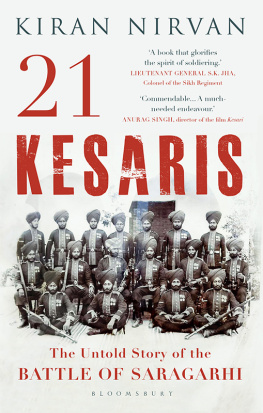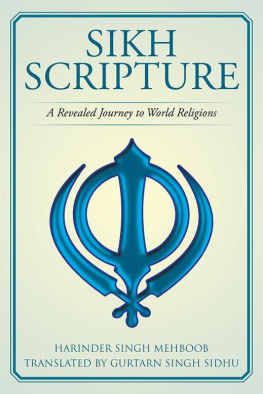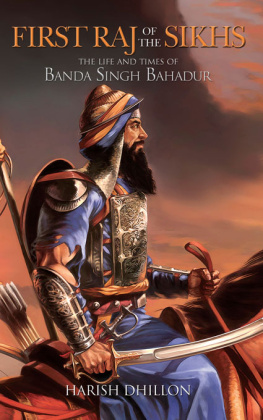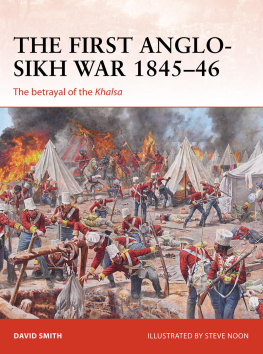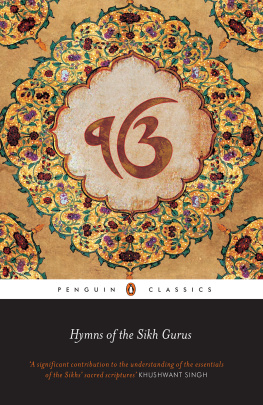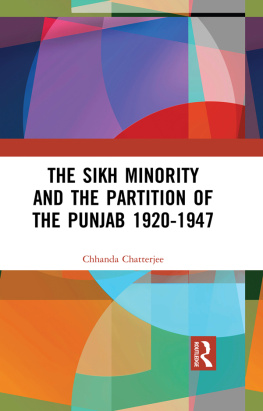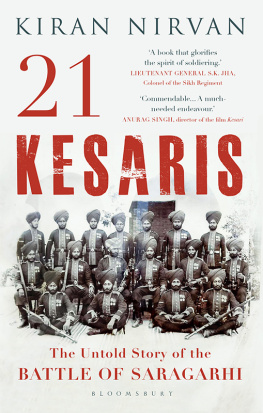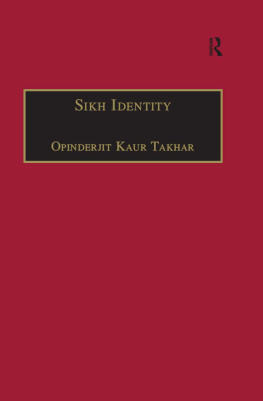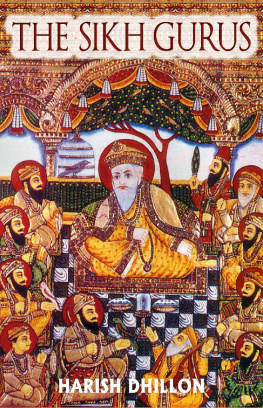Table of Contents



The Untold Story of the
BATTLE OF SARAGARHI
KIRAN NIRVAN

BLOOMSBURY INDIA
Bloomsbury Publishing India Pvt. Ltd
Second Floor, LSC Building No. 4, DDA Complex, Pocket C 6 & 7,
Vasant Kunj New Delhi 110070
BLOOMSBURY, BLOOMSBURY INDIA and the Diana logo are trademarks of Bloomsbury Publishing Plc
First published in India 2019
This edition published 2019
Copyright Nirvan Singh and Kirandeep Singh, 2019
Illustrations in Jagdeep Singh, 2019
Nirvan Singh and Kirandeep Singh have asserted their right under the Indian Copyright Act to be identified as authors of this work
All rights reserved. No part of this publication may be reproduced or transmitted in any form or by any means, electronic or mechanical, including photocopying, recording, or any information storage or retrieval system, without prior permission in writing from the publishers
The content of this book is the sole expression and opinion of its authors, and not of the publishers. The publisher in no manner is liable for any opinion or views expressed by the authors. While best efforts have been made in preparing this book, the publisher makes no representations or warranties of any kind and assumes no liabilities of any kind with respect to the accuracy or completeness of the content and specifically disclaims any implied warranties of merchant ability or fitness of use of a particular purpose.
ISBN: PB: 978-93-89000-39-9; eBook: 978-93-89000-41-2
2 4 6 8 10 9 7 5 3 1
Created by Manipal Digital Systems
Bloomsbury Publishing Plc makes every effort to ensure that the papers used in the manufacture of our books are natural, recyclable products made from wood grown in well-managed forests. Our manufacturing processes conform to the environmental regulations of the country of origin.
To find out more about our authors and books visit www.bloomsbury.com and sign up for our newsletters
This book is dedicated to the memory of all martyrs, the service of all veterans and the selfless conduct of all serving personnel of the Indian Army. We also dedicate this book to the unparalled bravery and exemplary courage of the officers and all ranks of 4 Sikh
(erstwhile the 36th Sikhs).
Contents
I n the humdrum of everyday life, where forgetfulness has become but a habitual phenomenon, it is not surprising to see history slip into oblivion. At a time when the present is at war with the future, the past fails to find its deserved place. Of course, many are familiar with the skeletal socio-political history of this nation, as is the purport of our school curriculum, but to know about battles and wars (besides the seminal victories or losses) is rare. However, it is important for a nation to appreciate her soldiers and for soldiers appreciate their legacy. To bridge the gap between a nation and the history of her armed forces, many tireless historians have given up their nights sleep trying to retrace and retell the epic saga of battles and wars.
The Battle of Saragarhi is one such battle of which very little is known to the general populace. In this episode of our countrys history, 21 gallant men faced the onslaught of 10,000 Orakzai and Afridi tribesmen on the fateful day of 12 September 1897. In a fierce stand that lasted for seven hours, these brave soldiers did not falter in the face of odds heavily stacked against them and laid down their lives to defend their post.
Reasons dictating the onset of wars and battles do not emerge overnight. There exists a bone of contention in most cases, if not all, and discontent often brews for years, sometimes decades or even centuries before erupting into war. Hence, even before the story of this great battle begins, it becomes undeniably essential to first understand the reasons that led to it. Another point to explain here is the fact that while this book may be judged as downright biased, such is the nature of this chronicle that a judgment cannot be entirely avoided. Having said that, we have done our best to base this narration on facts and recorded figures we have uncovered in the Army archives. While it was very hard to find information about these 21 soldiers of the 36th Sikh Regiment, now 4 Sikh, it was not impossible. Ashes to Glory, an informative book on the history of 4 Sikh, written by veteran of the unit Brigadier Kawaljit Singh, provided us with the basic framework for our research. The references to the socio-political landscape of the time in Colonel H.D. Hutchinsons literary work, Tirah 189798, were also helpful, as was Major Yatess work, The Life of Lieutenant Colonel John Haughton, which helped us paint an adequate picture of the Commanding Officer of the 36th Sikh Regiment during the battle of Saragarhi. These, and many other books describing the colonial era at the end of nineteenth century were required reading before we began writing this book. Of course, it would have been impossible to even start this book without the unremitting help provided by the Commanding Officer and officers of the 4 Sikh.
While we have tried to tell the story as simply as possible, and will make deliberate efforts to avoid a tone that resembles a history lecture, we as privileged legatees thriving on this countrys rich history must pledge to carry this legacy forward before it is buried in the sands of time. Brief fictional episodes based on our assessment of the battle have been added before some chapters in Part II we hope that these will help the reader connect with this piece of history at an emotional level. This battle deserves to be remembered, in isolation as well as a concrete testimony to the unparalleled bravery of Indians of which the world must be reminded from time to time. Therefore, everything that follows now will bear its own importance.
Waheguru ji ka khalsa, Waheguru ji ki fateh. (The Khalsa belongs to the Lord God! So the victory belongs to God!)
I n the vicinity of the famous Golden Temple in Amritsar rests a little-known cenotaph which bears immense significance in Indias colonial history. Often overshadowed by the famed Jallianwala Bagh, this forgotten memorial is inscribed with a legendary saga at par with the famed battle of three hundred Spartans against Xerxes and his massive Persian army: that of a daring stand of 21 warriors against the mammoth onslaught of ten thousand enemy fighters that took place almost a century ago. The unprecedented bravery shown in the fierce battle forever changed the way Britain and the world looked at Indian soldiers, especially Sikh soldiers. However, unlike in the rest of the world where writers and poets have immortalized the exceptional valour of their countrymen in verse, Indian history books almost never mention the battle that once swept the British Parliament off its feet.
Taking a leap back to the nineteenth century will provide necessary insights into events that culminated in the epic battle that took place at Saragarhi, particularly those pertaining to the history of India, Britain, Russia and Afghanistan. Nineteenth century was a crucial period in the histories of these countries, one now known as the Great Game, derived from heightened tensions between Britain and Russia as they battled for control over important territories in central Asia. By the end of eighteenth century, even as Indias wounds from the tyrannical rule of latter-day Mughal kings had not yet healed, it fell victim to Britains desire for economic prosperity as well as recognition as a world power. After the French Revolution, European powers began to leave their shores in search of new lands to conquer, both for resources and dominion. In the early 1800s, the Industrial Revolution was beginning across the world and Great Britain was one such place where raw materials and new markets were in great demand in order to sustain the new industries. After Vasco da Gama landed on the shores of India in 1498, it was no longer hidden from the world that India was a country rich in resources and, for Britain, it became a priority to colonize India to stamp their authority across the world.

